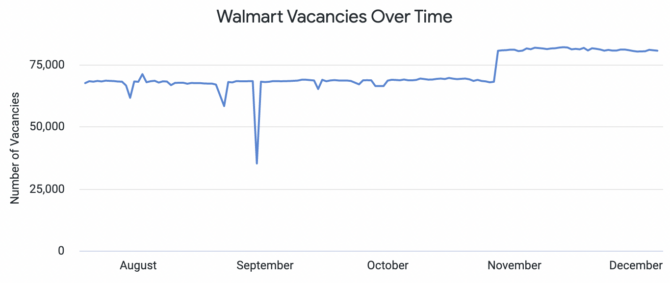
Introducing Our Business Intelligence Product: Job Market Pulse
In response to customer demand, we’ve consolidated our industry-leading database of real-time job listings under one brand. We call it Job Market Today. It currently includes almost 10 million direct-from-company website job postings, updated daily.
Under the Job Market Today umbrella is a new and improved product we call Job Market Pulse. Inspired by our customers’ desires to gather competitive business intelligence, Job Market Pulse makes it easy to break down every piece of information our database of job listings provides.
Here, we’ll dive into five things you can do with Job Market Pulse, and how it helps you identify job trends big and small.
1. See What’s Happening in the Job Market in Real Time
If you’re currently recruiting workers, you know firsthand how competitive the labor market has been – even with recent tech layoffs. You also know that competitors are doing more to attract talent. And if you want to keep pace, you likely need to do the same.
So you decide to research the salaries and benefits other employers are offering in your space. But you realize the platforms that promise granular job market data only update their databases every month or so, and sometimes even less often.
When the average hiring process lasts 36 days, even the latest data available is already, by the time you see it, out of date.
Job Market Pulse solves this problem for you. We update our job openings data every day. That means you can accurately track the going salary rates for listings similar to yours – and how competitive they are.
2. Track Historical Changes in the Job Market
Old data isn’t a reliable way to capture what’s currently happening in the job market. But tracking job openings data over time is crucial for understanding changes in your industry and the economy more broadly.
Let’s say you’re a state chamber of commerce interested in knowing how salaries are trending in an industry you’re targeting for development – say, green jobs. Job Market Pulse can help. Because we offer historical data, you can see how everything from salaries to the number of job postings has changed in different sectors over the days, weeks, months, and years.
3. Find Out When Your Competitors Are Hiring – and for What Roles
Say you’re in a crowded B2B tech space. You’ve heard that many tech firms are prioritizing diversity, equity, and inclusion (DE&I), and you want to see what competitors are doing to deliver on it.
You know one indicator of DE&I commitment is including salaries in job listings. You check Job Market Pulse. Most competitors aren’t listing salaries. This gives you an opportunity to stand out. Plus, seeing the salaries from the few competitors that include them gives you more data to inform what wages you should offer.
Because you’re able to view historic hiring data, you can also track the hiring cycles of competitors. Do they frequently hire for the same sales roles? Do their job listings for developers and engineers coincide with funding announcements? Whatever the answer, you can use those insights to fuel your competitive intelligence.
4. Stay on Top of the Job Market Data You’re Tracking
You’re busy. You don’t have time to analyze job openings data every day. Who does? But that doesn’t mean you should miss the opportunity to spot important events happening in real time. That’s why Job Market Pulse features alerts that you can program to fit your needs.
Let’s borrow from the DEI role hiring example from earlier. If you’re gathering competitive intelligence – and want to track a competitor’s DEI-related job openings – our job alerts can notify you via email once those openings pop up, or change, in our database.
You can also set up alerts for bigger-picture changes. Maybe you want a notification when the number of IT-related positions in your region reaches a certain threshold. Or maybe you want to know when competitors in states that mandate salary transparency start adding salaries to existing job listings.
With alerts, you don’t need to glue yourself to a computer to track the job market changes you’re interested in. Job Market Pulse does that work for you.
5. View Job Openings Data the Way You Want
So you have all the information you need at your fingertips. But none of that is helpful without a dashboard to help you digest it.
Maybe you want to track every CNA job in California that’s been posted in the past 30 days (1,505 as of December 12, 2022). Maybe you want the number of jobs that include salary information in New York (15,560 as of December 12, 2022). Maybe you want to track an individual company’s job openings (Figure 1).

Whatever it is that you want to see, we can set up your Job Market Pulse dashboard to visualize it for you.
Want More Competitive Data? We Work with You to Get It
Today, Job Market Today has over nine million job openings, updated daily, in our database. That’s a lot – but we’re still growing. And we want to do it with you. So if there’s a metro market or specific employer you’d like intel on, let us know. We’ll scrape the job listings you want and need.
Interested in hearing more about Job Market Pulse? Want a way to track live job openings data? Reach out! We’d love to speak with you.